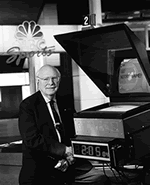
Ask Hubert J. “Hub” Schlafly ‘41 how the first TelePrompTer worked and he’ll say, “Barely.”
He should know. He built it. Out of a suitcase. Schlafly was working as director of television research for Twentieth Century Fox in the early 1950s when an actor named Fred Barton walked into the New York office of one of Schlafly’s colleagues at Fox, Irving Berlin Kahn, nephew of the famous songwriter. Barton, who was appearing on Broadway with Henry Fonda at the time in Mister Roberts, realized that daily TV shows like soap operas left too little time for actors to memorize new scripts day after day. What if, he wondered, the actors could glance up as needed at various locations at the front of the set where scripts printed in giant letters would be scrolling along with the dialogue?
Kahn, Fox’s manager of radio and television called in the company’s technical expert, Schlafly, to discuss whether Barton’s hand-cranked script-scrolling box model held any promise. They agreed that it did. Their bosses at Fox didn’t. But they allowed them to pursue the idea in their spare time. About a year later Kahn, Barton and Schlafly quit their jobs and formed a partnership. The union would become the TelePrompTer Corporation, and “teleprompter” would become part of the lexicon as the name for any script-displaying device.
Interestingly, Barton, Fox and Schlafly saw their enterprise not as a builder and seller of TelePrompTer machines, which they never patented, but as a service. They’d retype scripts or speeches in oversized letters on paper scrolls and then run them on a TelePrompTer controlled off-stage by trained company technicians.
Schlafly had constructed the company’s first prompting machine out of a large suitcase with one side cut out. It weighed 40 pounds. Improved models were used for the first time on TV on a live CBS soap opera called The First Hundred Years. The show aired at noon, allowing Kahn and Schlafly to rush over to the studio from Fox on their lunch hour.
The partner’s big break came at the Republican National Convention of 1952 when former President Herbert Hoover gave the keynote address using a TelePompTer positioned conspicuously in front of the podium. Later came innovations like SpeechVue optical outriders, those now-familiar glass panels one sees flanking a podium. The panels are two-way mirrors, clear on the side facing audience and mirrored on the opposite side to reflect a projection of the speaker’s script.
TelePrompTer’s partners shrewdly sold the prompting business in the early 1960s to pursue a promising new arena, cable TV. In the 1970s, with Schlafly as president, the company grew into the largest multisystem cable operator in the country before being sold to Westinghouse.
Schlafly, who also pioneered the cable converter box, holds 16 patents, the most recent awarded in 1988 for a hand-held computerized device for ordering goods and services from a supplier, a precursor of e-commerce. He has been awarded two Emmys for contributions to television technology, the second of which he received in1999 as the last surviving partner of TelPrompTer Corporation. The award recognizes the company’s Lens Line Prompting System, a companion of the SpeechVue that superimposes the words directly in front of a TV camera lens on a two-way mirror.
“It’s like shooting through a window pane,” the inventor says. This is what allows news anchors to look viewers squarely and continually in the eye.
Schlafly says he never set out to be an inventor and still doesn’t think of himself as one. The patents, he says, all resulted from working with others to solve problems.
On the other hand, he’s fond of saying there are three phases to all inventions:
“One is the wild-eyed guy who has an idea, sees a need and has the technical background two address it.
“Two is finding sufficient financial backing to create something that might be marketable.
“And three is when everybody looks at it and says, ‘Anybody could have done that.’”